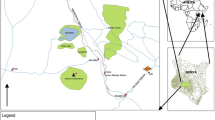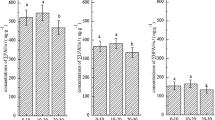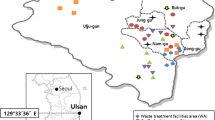Abstract
Purpose
Political tensions in Iraq have made attention to environmental issues not a priority for the authorities. Therefore, the influence of Kirkuk and Erbil refineries on contamination of the surrounding soil by polycyclic aromatic hydrocarbons (PAHs), were studied.
Methods
25 soil samples were collected and analyzed using high-performance liquid chromatography (HPLC), and their fate and health risk were investigated using Exposure Model for Soil-Organic Fate and Transport (EMSOFT) and the Monte Carlo Simulation (MCS) model.
Results
High ∑PAHs contamination (raged from 212.8 to 12,790.4 ppb), the dominance of pyrogenic sources, and high ecological risk were observed. The mean hazard index values for children (0.043) are higher than those for adults (0.02), while the incremental lifetime carcinogenic risk values for adults (8.50E-4) are greater than those for children (5.27E-4). Pyrene is the significant soil PAH from the depth of 3 cm downwards, while phenanthrene and fluorene are the major constituents of PAHs between the depth of 3 and 10 cm. Also, low molecular weight PAHs significantly decrease in soil layers over the time frame, and maximum PAHs concentrations belong to high molecular weight PAHs over 20 years.
Conclusion
Using an appropriate monitoring system, as well as sound management decisions to reduce the emission of environmental pollution are needed. Also, it seems that the use of constant values for soil physicochemical parameters such as moisture and porosity, despite seasonal variations, may result in uncertainty for fate and transport modelling. Therefore, seasonal sampling and analysis of soil parameters, would be helpful.







Similar content being viewed by others
Data availability
Not applicable.
Code availability
Not applicable.
References
Akyüz M, Çabuk H. Gas–particle partitioning and seasonal variation of polycyclic aromatic hydrocarbons in the atmosphere of Zonguldak, Turkey. Sci Total Environ. 2010;408(22):5550–8.
Abbasnia A, Ghoochani M, Yousefi N, Nazmara S, Radfard M, Soleimani H, Yousefi M, Barmar S, Alimohammadi M. Prediction of human exposure and health risk assessment to trihalomethanes in indoor swimming pools and risk reduction strategy. Hum Ecol Risk Assess Int J. 2019;25(8):2098–115.
Amjadian K, Pirouei M, Mehr MR, Shakeri A, Rasool SK, Haji DI. Contamination, health risk, mineralogical and morphological status of street dusts-case study: Erbil metropolis, Kurdistan Region-Iraq. Environ Pollut. 2018;243:1568–78.
Annicchiarico C, Buonocore M, Cardellicchio N, Di Leo A, Giandomenico S, Spada L. PCBs, PAHs and metal contamination and quality index in marine sediments of the Taranto Gulf. Chem Ecol. 2011;27(S1):21–32.
Brogowski Z, Kwasowski W, Madyniak R. Calculating particle density, bulk density, and total porosity of soil based on its texture. Soil Sci Annu. 2014;65(4):139–49.
Cai C, Li J, Wu D, Wang X, Tsang DC, Li X, et al. Spatial distribution, emission source and health risk of parent PAHs and derivatives in surface soils from the Yangtze River Delta, eastern China. Chemosphere. 2017;178:301–8.
Cao Z, Liu J, Luan Y, Li Y, Ma M, Xu J, Han S. Distribution and ecosystem risk assessment of polycyclic aromatic hydrocarbons in the Luan River, China. Ecotoxicology. 2010;19(5):827–37.
Chen M, Huang P, Chen L. Polycyclic aromatic hydrocarbons in soils from Urumqi, China: distribution, source contributions, and potential health risks. Environ Monit Assess. 2013;185(7):5639–51.
Chen Y, Jia R, Yang S. Distribution and source of polycyclic aromatic hydrocarbons (PAHs) in water dissolved phase, suspended particulate matter and sediment from Weihe river in Northwest China. Int J Environ Res Public Health. 2015;12(11):14148–63.
Chen W, Wu X, Zhang H, Sun J, Liu W, Zhu L, et al. Contamination characteristics and source apportionment of methylated PAHs in agricultural soils from Yangtze River Delta, China. Environ Pollut. 2017;230:927–35.
Chen Y, Zhang J, Zhang F, Liu X, Zhou M. Contamination and health risk assessment of PAHs in farmland soils of the Yinma River Basin, China. Ecotoxicol Environ Saf. 2018;156:383–90.
Chen G, Wang X, Wang R, Liu G. Health risk assessment of potentially harmful elements in subsidence water bodies using a Monte Carlo approach: An example from the Huainan coal mining area, China. Ecotoxicol Environ Saf. 2019;171:737–45.
Dahle S, Savinov VM, Matishov GG, Evenset A, Næs K. Polycyclic aromatic hydrocarbons (PAHs) in bottom sediments of the Kara Sea shelf, Gulf of Ob and Yenisei Bay. Sci Total Environ. 2003;306(1–3):57–71.
Fallahzadeh RA, Khosravi R, Dehdashti B, Ghahramani E, Omidi F, Adli A, Miri M. Spatial distribution variation and probabilistic risk assessment of exposure to chromium in ground water supplies; a case study in the east of Iran. Food Chem Toxicol. 2018;115:260–6.
Frédéric O, Yves P. Pharmaceuticals in hospital wastewater: their ecotoxicity and contribution to the environmental hazard of the effluent. Chemosphere. 2014;115:31–9.
Fu S, Cheng HX, Liu YH, Xia XJ, Xu XB. Composition, distribution, and characterization of polycyclic aromatic hydrocarbons in the soil in Linfen, China. Bull Environ Contam Toxicol. 2009;82(2):167–71.
Fu XW, Li TY, Ji L, Wang LL, Zheng LW, Wang JN, Zhang Q. Occurrence, sources and health risk of polycyclic aromatic hydrocarbons in soils around oil wells in the border regions between oil fields and suburbs. Ecotoxicol Environ Saf. 2018;157:276–84.
Ganyaglo SY, Gibrilla A, Teye EM, Owusu-Ansah EDGJ, Tettey S, Diabene PY, Asimah S. Groundwater fluoride contamination and probabilistic health risk assessment in fluoride endemic areas of the Upper East Region, Ghana. Chemosphere. 2019;233:862–72.
Gereslassie T, Workineh A, Liu X, Yan X, Wang J. Occurrence and Ecological and Human Health Risk Assessment of Polycyclic Aromatic Hydrocarbons in Soils from Wuhan, Central China. Int J Environ Res Public Health. 2018;15(12):2751.
Halek F, Nabi G, Kavousi A. Polycyclic aromatic hydrocarbons study and toxic equivalency factor (TEFs) in Tehran, Iran. Environ Monit Assess. 2008;143(1–3):303–11.
Helsel DR, Hirsch RM. Statistical Methods in Water Resources. In Techniques of Water-Resources Investigations of the United States Geological Survey: Book 4, Chapter A3; U.S. Geological Survey: Alexandrla, VA, USA, p. 522; 2002.
IARC. IARC monographs on the evaluation of carcinogenic risks to humans., In: International Agency for Research in Cancer. 2010. Web site 22.02.2011, Available from http://monographs.iarc.fr/ENG/Classification/index.php
Jadoon WA, Sakugawa H. Concentrations of polycyclic aromatic hydrocarbons: Their potential health risks and sources at three non-urban sites in Japan. J Environ Sci Health A. 2016;51(11):884–99.
Jegadeesan GB, Balamurugan D, Karthik R, Ananthanarayanan V. Modeling Volatilization Flux of Semi-Volatile Organic Compounds from Soil. Res J Pharm, Biol Chem Sci. 2016;7(6):2436–45.
Kalf DF, Crommentuijn T, van de Plassche EJ. Environmental quality objectives for 10 polycyclic aromatic hydrocarbons (PAHs). Ecotoxicol Environ Saf. 1997;36(1):89–97.
Kapsimalis V, Panagiotopoulos IP, Talagani P, Hatzianestis I, Kaberi H, Rousakis G, et al. Organic contamination of surface sediments in the metropolitan coastal zone of Athens, Greece: Sources, degree, and ecological risk. Mar Pollut Bull. 2014;80(1–2):312–24.
Khpalwak W, Jadoon WA, Abdel-dayem SM, Sakugawa H. Polycyclic aromatic hydrocarbons in urban road dust, Afghanistan: Implications for human health. Chemosphere. 2019;218:517–26.
Kwon HO, Choi SD. Polycyclic aromatic hydrocarbons (PAHs) in soils from a multi-industrial city, South Korea. Sci Total Environ. 2014;470:1494–501.
Li J, Dong H, Zhang D, Han B, Zhu C, Liu S, et al. Sources and ecological risk assessment of PAHs in surface sediments from Bohai Sea and northern part of the Yellow Sea, China. Mar Pollut Bull. 2015;96(1–2):485–90.
Li R, Cheng M, Cui Y, He Q, Guo X, Chen L, Wang X. Distribution of the Soil PAHs and Health Risk Influenced by Coal Usage Processes in Taiyuan City, Northern China. Int J Environ Res Public Health. 2020;17(17):6319.
Liu A, Lang Y, Xue L, Liu J. Ecological risk analysis of polycyclic aromatic hydrocarbons (PAHs) in surface sediments from Laizhou Bay. Environ Monit Assess. 2009;159(1–4):429.
Liu F, Liu J, Chen Q, Wang B, Cao Z. Pollution characteristics and ecological risk of polycyclic aromatic hydrocarbons (PAHs) in surface sediments of the southern part of the Haihe River system in China. Chin Sci Bull. 2013;58(27):3348–56.
Liu MX, Yang YY, Yun XY, Zhang MM, Wang J. Occurrence, sources, and cancer risk of polycyclic aromatic hydrocarbons and polychlorinated biphenyls in agricultural soils from the Three Gorges Dam region, China. J Soil Water Conserv. 2016;71(4):327–34.
Liu H, Yu X, Liu Z, Sun Y. Occurrence, characteristics and sources of polycyclic aromatic hydrocarbons in arable soils of Beijing, China. Ecotoxicol Environ Saf. 2018;159:120–6.
Liu J, Liu YJ, Liu Z, Zhang A, Liu Y. Source apportionment of soil PAHs and human health exposure risks quantification from sources: the Yulin National Energy and Chemical Industry Base, China as case study. Environ Geochem Health. 2019;41(2):617–32.
Long ER, Macdonald DD, Smith SL, Calder FD. Incidence of adverse biological effects within ranges of chemical concentrations in marine and estuarine sediments. Environ Manag. 1995;19(1):81–97.
Long Y, Dai T, Wu Q. Sources and distribution of polycyclic aromatic hydrocarbons in street dust from the Chang-Zhu-Tan Region, Hunan, China. Environ Monit Assess. 2013;185(2):1377–90.
Macdonald DD, Carr RS, Calder FD, Long ER, Ingersoll CG. Development and evaluation of sediment quality guidelines for Florida coastal waters. Ecotoxicology. 1996;5(4):253–78.
Manikandan S. Measures of central tendency: Median and mode. J Pharmacol Pharmacother. 2011;2(3):214.
McCready S, Birch GF, Long ER. Metallic and organic contaminants in sediments of Sydney Harbour, Australia and vicinity—a chemical dataset for evaluating sediment quality guidelines. Environ Int. 2006;32(4):455–65.
Nematollahi MJ, Dehdaran S, Moore F, Keshavarzi B. Potentially toxic elements and polycyclic aromatic hydrocarbons in street dust of Yazd, a central capital city in Iran: contamination level, source identification, and ecological-health risk assessment. Environ Geochem Health (in press). 2020. https://doi.org/10.1007/s10653-020-00682-4.
Netto ADP, Krauss TM, Cunha IF, Rego EC. PAHs in SD: Polycyclic aromatic hydrocarbons levels in street dust in the central area of Niterói City, RJ, Brazil. Water Air Soil Pollut. 2006;176(1):57–67.
Orecchio S. Contamination from polycyclic aromatic hydrocarbons (PAHs) in the soil of a botanic garden localized next to a former manufacturing gas plant in Palermo (Italy). J Hazard Mater. 2010;180(1–3):590–601.
Ortiz R, Vega S, Gutiérrez R, Gibson R, Schettino B, de Lourdes Ramirez M. Presence of polycyclic aromatic hydrocarbons (PAHs) in top soils from rural terrains in Mexico City. Bull Environ Contam Toxicol. 2012;88(3):428–32.
Paraíba LC, Queiroz SC, de Souza DR, Saito ML. Risk simulation of soil contamination by polycyclic aromatic hydrocarbons from sewage sludge used as fertilizers. J Braz Chem Soc. 2011;22(6):1156–63.
Peng C, Chen W, Liao X, Wang M, Ouyang Z, Jiao W, Bai Y. Polycyclic aromatic hydrocarbons in urban soils of Beijing: status, sources, distribution and potential risk. Environ Pollut. 2011;159(3):802–8.
Qu L, Huang H, Xia F, Liu Y, Dahlgren RA, Zhang M, Mei K. Risk analysis of heavy metal concentration in surface waters across the rural-urban interface of the Wen-Rui Tang River, China. Environ Pollut. 2018;237:639–49.
Soltani N, Keshavarzi B, Moore F, Tavakol T, Lahijanzadeh AR, Jaafarzadeh N, Kermani M. Ecological and human health hazards of heavy metals and polycyclic aromatic hydrocarbons (PAHs) in road dust of Isfahan metropolis, Iran. Sci Total Environ. 2015;505:712–23.
Sun H, Qi Y, Zhang D, Li QX, Wang J. Concentrations, distribution, sources and risk assessment of organohalogenated contaminants in soils from Kenya, Eastern Africa. Environ Pollut. 2016;209:177–85.
Sushkova S, Minkina T, Deryabkina I, Rajput V, Antonenko E, Nazarenko O, et al. Environmental pollution of soil with PAHs in energy producing plants zone. Sci Total Environ. 2019;655:232–41.
Tang L, Tang XY, Zhu YG, Zheng MH, Miao QL. Contamination of polycyclic aromatic hydrocarbons (PAHs) in urban soils in Beijing, China. Environ Int. 2005;31(6):822–8.
Taqi AH, Al Nuaimy QA, Karem GA. Study of the properties of soil in Kirkuk, IRAQ. J Radiat Res Appl Sci. 2016;9(3):259–65.
Tong R, Yang X, Su H, Pan Y, Zhang Q, Wang J, Long M. Levels, sources and probabilistic health risks of polycyclic aromatic hydrocarbons in the agricultural soils from sites neighboring suburban industries in Shanghai. Sci Total Environ. 2018;616:1365–73.
USEPA. Emsoft User's Guide and Modeling Software. U.S. Environmental Protection Agency, Office of Research and Development, National Center for Environmental Assessment, Washington Office, Washington, DC, NCEA/W-0073, NCEA/W-0073, 2002. 2002.
USEPA. Example Exposure Scenarios. National Center for Environmental Assessment, Washington, DC; EPA/600/R-03/036. Available from: National Information Service, Springfield, VA; PB2003-103280 and at http://www.epa.gov/ncea. 2003.
USEPA. Risk Assessment Guidance for Superfund Volume I: Human Health Evaluation Manual (Part E, Supplemental Guidance for Dermal Risk Assessment). Office of Superfund Remediation and Technology Innovation. EPA/540/R/99/005. 2004.
USEPA. Child-Specific Exposure Factors Handbook. EPA/600/R-06/096F. 2008.
USEPA. Exposure Factors Handbook: 2011 Edition. EPA/600/R-090/052F. 2011.
USEPA. Mid-Atlantic Risk Assessment, Regional Screening Table - User's Guide. http://www.epa.gov/reg3hwmd/risk/human/rb-concentration_table/usersguide.htm. 2012.
USEPA. Human Health Evaluation Manual, Supplemental Guidance: Update of Standard Default Exposure Factors, OSWER Directive 9200.1-120. 2014.
USEPA. Toxicological Review of Benzo[a]pyrene. EPA/635/R-17/003Fc. 2017.
USEPA, A. Risk assessment guidance for superfund. Volume I: human health evaluation manual (part a). EPA/540/1-89/002. 1989.
Wang W, Huang MJ, Kang Y, Wang HS, Leung AO, Cheung KC, Wong MH. Polycyclic aromatic hydrocarbons (PAHs) in urban surface dust of Guangzhou, China: Status, sources and human health risk assessment. Sci Total Environ. 2011;409(21):4519–27.
Wang XT, Miao Y, Zhang Y, Li YC, Wu MH, Yu G. Polycyclic aromatic hydrocarbons (PAHs) in urban soils of the megacity Shanghai: occurrence, source apportionment and potential human health risk. Sci Total Environ. 2013;447:80–9.
Wang J, Zhang X, Ling W, Liu R, Liu J, Kang F, Gao Y. Contamination and health risk assessment of PAHs in soils and crops in industrial areas of the Yangtze River Delta region, China. Chemosphere. 2017;168:976–87.
Wang L, Zhang P, Wang L, Zhang W, Shi X, Lu X, et al. Polycyclic Aromatic Hydrocarbons in Urban Soil in the Semi-arid City of Xi’an, Northwest China: Composition, Distribution, Sources, and Relationships with Soil Properties. Arch Environ Contam Toxicol. 2018:1–16.
Wester RC, Maibach HI, Bucks DA, Sedik L, Melendres J, Liao C, DiZio S. Percutaneous absorption of [14C] DDT and [14C] benzo [a] pyrene from soil. Toxicol Sci. 1990;15(3):510–6.
Williams SB, Shan Y, Jazzar U, Kerr PS, Okereke I, Klimberg VS, et al. Proximity to oil refineries and risk of cancer: A population-based analysis. JNCI Cancer Spectrum. 2020;4(6):pkaa088.
Wu B, Zhang R, Cheng SP, Ford T, Li AM, Zhang XX. Risk assessment of polycyclic aromatic hydrocarbons in aquatic ecosystems. Ecotoxicology. 2011;20(5):1124–30.
Xiao R, Bai J, Wang J, Lu Q, Zhao Q, Cui B, Liu X. Polycyclic aromatic hydrocarbons (PAHs) in wetland soils under different land uses in a coastal estuary: Toxic levels, sources and relationships with soil organic matter and water-stable aggregates. Chemosphere. 2014;110:8–16.
Xu J, Yu Y, Wang P, Guo W, Dai S, Sun H. Polycyclic aromatic hydrocarbons in the surface sediments from Yellow River, China. Chemosphere. 2007;67(7):1408–14.
Yukhimets A, Kuzu SL, Akyüz E, Saral A. Investigation of geospatial distribution of PAH compounds in soil phase and determination of soil–air exchange direction in a megacity. Environ Geochem Health. 2019:1–14.
Yunker MB, Macdonald RW, Vingarzan R, Mitchell RH, Goyette D, Sylvestre S. PAHs in the Fraser River basin: a critical appraisal of PAH ratios as indicators of PAH source and composition. Org Geochem. 2002;33(4):489–515.
Zhou R, Qin X, Peng S, Deng S. Total petroleum hydrocarbons and heavy metals in the surface sediments of Bohai Bay, China: long-term variations in pollution status and adverse biological risk. Mar Pollut Bull. 2014;83(1):290–7.
Zhu F, Yang S, Fan W, Wang A, Hao H, Yao S. Heavy metals in jujubes and their potential health risks to the adult consumers in Xinjiang province, China. Environ Monit Assess. 2014;186(10):6039–46.
Zhu Y, Duan X, Qin N, Lv J, Wu G, Wei F. Health risk from dietary exposure to polycyclic aromatic hydrocarbons (PAHs) in a typical high cancer incidence area in southwest China. Sci Total Environ. 2019;649:731–8.
Zhang W, Zhang S, Wan C, Yue D, Ye Y, Wang X. Source diagnostics of polycyclic aromatic hydrocarbons in urban road runoff, dust, rain and canopy throughfall. Environ Pollut. 2008;153(3):594–601.
Acknowledgment
The authors would like to state their thankfulness to the Scientific Research Center of Soran University for making this research possible.
Author information
Authors and Affiliations
Corresponding author
Ethics declarations
Conflicts of interest
The authors declare that they have no conflict of interest.
Additional information
Publisher’s note
Springer Nature remains neutral with regard to jurisdictional claims in published maps and institutional affiliations.
Supplementary Information
Below is the link to the electronic supplementary material.
Rights and permissions
About this article
Cite this article
Nematollahi, M.J., Rastegari Mehr, M., Shakeri, A. et al. Polycyclic aromatic hydrocarbons (PAHs) in soils around oil refineries; Case study: Erbil and Kirkuk refineries, Iraq- A modelling approach. J Environ Health Sci Engineer 20, 699–716 (2022). https://doi.org/10.1007/s40201-022-00809-y
Received:
Accepted:
Published:
Issue Date:
DOI: https://doi.org/10.1007/s40201-022-00809-y




